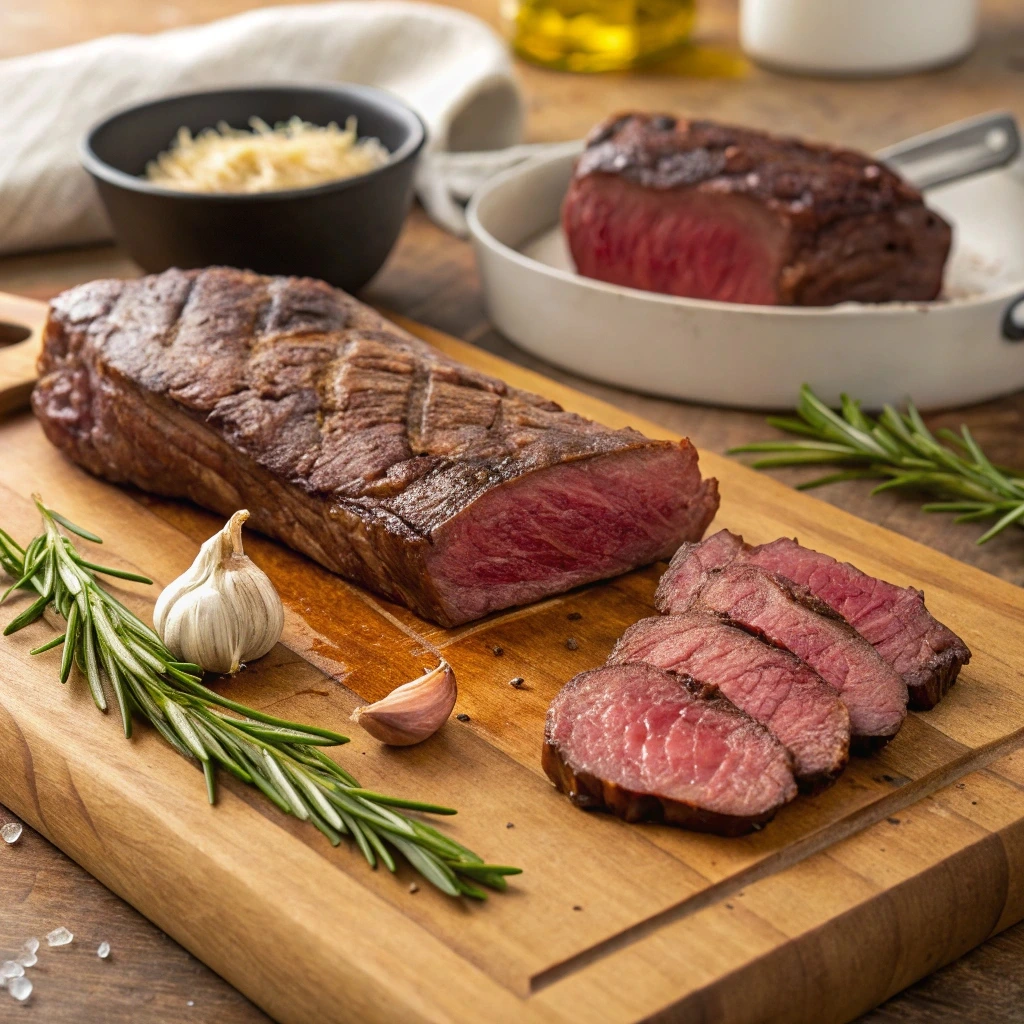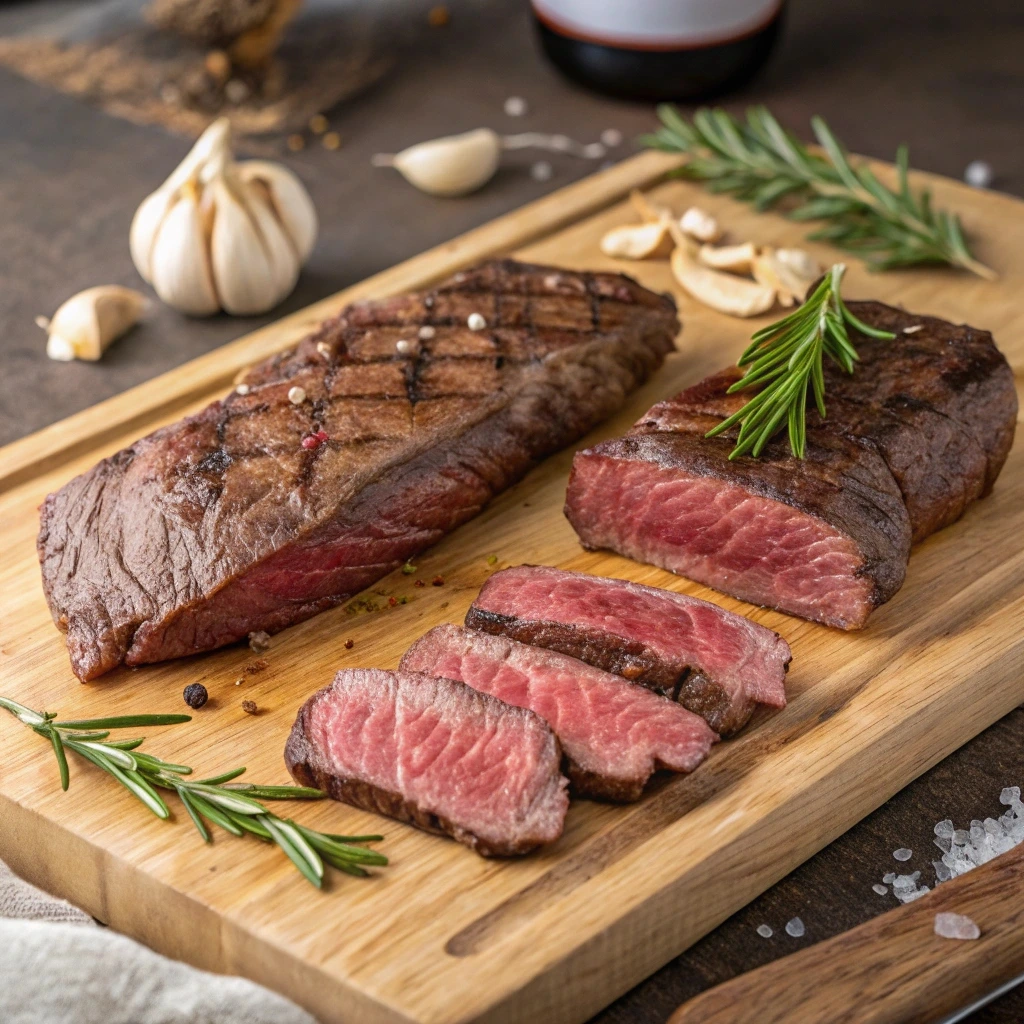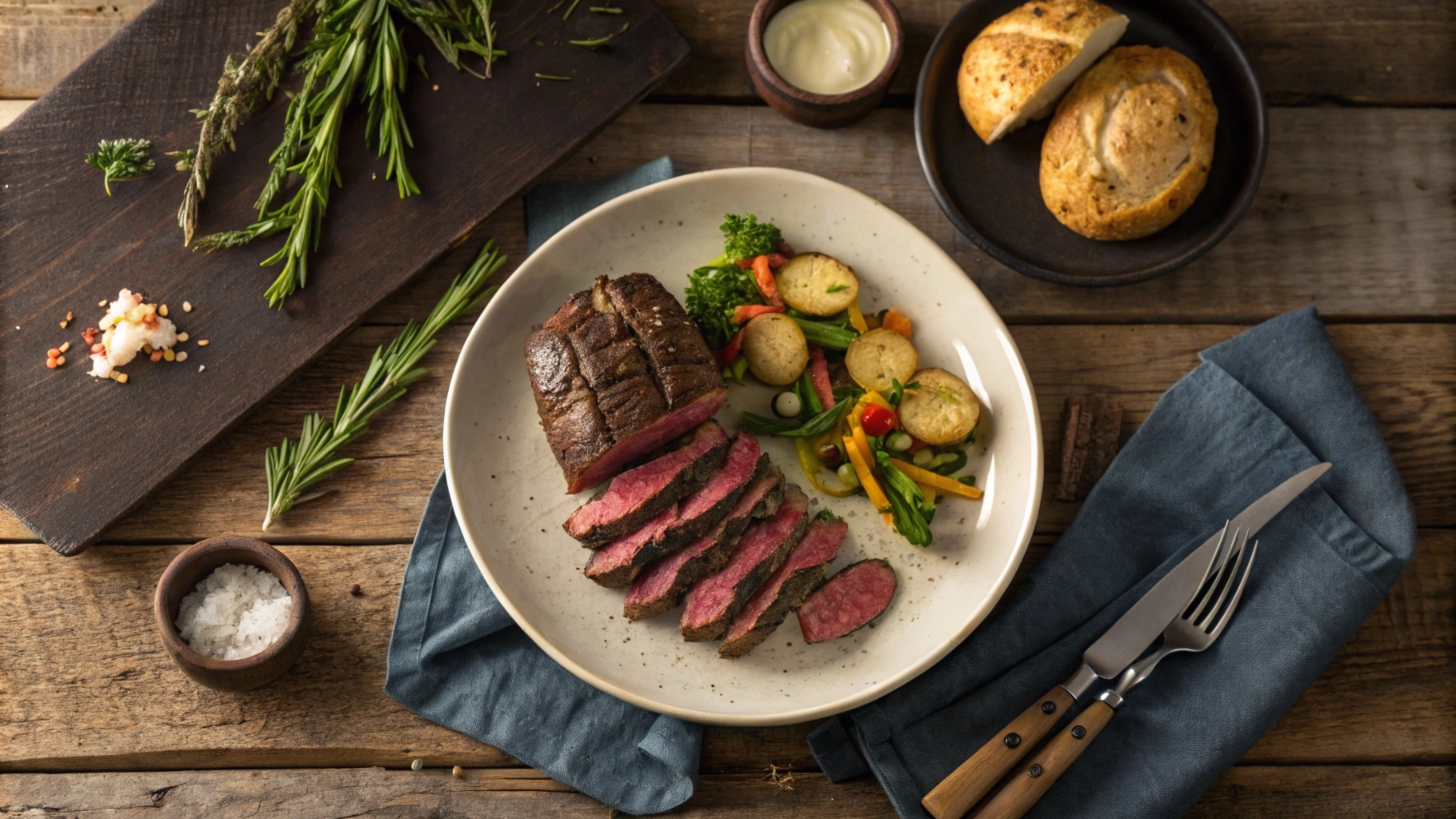Hanger steak, often called the “butcher’s steak,” is celebrated for its rich flavor and versatility, making it a popular choice among chefs and home cooks alike. However, a common question that arises is: “Is hanger steak tough or tender?” Hanger steak is naturally tender, but its final texture is influenced by the method of preparation and cooking.
To begin with, This cut is taken from the plate section of the cow, where it is located near the diaphragm and “hangs” in place.
Because this muscle sees little use, hanger steak is exceptionally tender, making it softer than cuts like skirt or flank steak. Transitioning to its flavor, hanger steak boasts bold, beefy notes that are further enhanced by its natural marbling and coarse grain structure.
That said, improper preparation can compromise its tenderness. For instance, overcooking can dry out the meat, while slicing with the grain may result in a chewy texture. Additionally, skipping resting time can cause the juices to escape, leaving the steak less flavorful. However, by using quick, high-heat methods like grilling or pan-searing, letting it rest after cooking, and slicing against the grain, you can ensure hanger steak retains its signature tenderness When cooked properly, it delivers an exceptional and flavorful dining experience.
For more inspiration, check out our guide to quick Lunch recipes
What Makes Hanger Steak Unique?
To understand whether hanger steak is tough or tender, it’s important to first examine its characteristics. This cut is sourced from the plate section of the cow, where it “hangs” near the diaphragm. Because the muscle does very little work, hanger steak is naturally tender, offering a softer texture compared to cuts like flank or skirt steak.
Transitioning to its structure, hanger steak features coarse grains and light marbling, both of which contribute to its bold, beefy flavor. These grains, however, require attention when slicing, as improper cutting can impact its tenderness. By slicing against the grain, you shorten the muscle fibers, ensuring each bite is as tender as possible.
Additionally, hanger steak’s unique location and minimal use as a muscle give it a melt-in-your-mouth quality when prepared correctly. Whether grilled, pan-seared, or broiled, hanger steak’s combination of rich flavor and natural tenderness makes it a standout choice for a variety of dishes. With proper preparation and slicing techniques, you can enjoy this flavorful cut at its very best.
Is Hanger Steak Tough or Tender?
Hanger steak is naturally tender, making it a popular choice among chefs and food enthusiasts. However, if not cooked or prepared correctly, it can feel tough. Let’s break down what affects its texture:
1. Natural Tenderness
The muscle’s limited activity results in a tender cut of meat. When cooked to medium-rare or medium, hanger steak delivers a juicy, melt-in-your-mouth experience.
2. Cutting Technique
Slicing hanger steak against the grain is essential. Slicing against the grain shortens the muscle fibers, resulting in a more tender and enjoyable bite. Cutting with the grain, on the other hand, can make it seem chewy.
3. Cooking Method
Quick, high-heat cooking methods like grilling, pan-searing, or broiling are best for hanger steak. Overcooking can make it tough, as the steak loses its juices and dries out.

Benefits of Hanger Steak
To fully understand why hanger steak is a favorite among chefs and food enthusiasts, here’s a breakdown of its key benefits:
| Benefit | Description |
|---|---|
| Rich Flavor | Bold, beefy taste that stands out, making it ideal for hearty, flavorful dishes. |
| Natural Tenderness | Minimal muscle use ensures a tender cut that melts in your mouth when cooked properly. |
| Versatility | Adapts well to grilling, pan-searing, broiling, or slicing for various recipes. |
| Quick Cooking Time | Cooks in minutes over high heat, perfect for busy weeknights or casual dinners. |
| Affordable Alternative | Offers a premium taste at a more affordable price than cuts like ribeye or tenderloin. |
| Customizable Flavor | Absorbs marinades well for those looking to experiment with different cuisines. |
| Impressive Presentation | Sliced against the grain, it creates an elegant dish for special occasions. |
By leveraging these benefits, hanger steak stands out as a versatile, flavorful, and cost-effective option for home cooks and professionals alike.
Tips for Ensuring Tender Hanger Steak
Transitioning to practical advice, here are some tips to guarantee a tender, flavorful steak:
- Cook to Medium-Rare or Medium: Aim for an internal temperature of 130–135°F to maintain juiciness and tenderness.
- Allow the steak to rest for 5–10 minutes after cooking to ensure the juices redistribute before slicing. This helps the juices redistribute, resulting in a moist texture.
- Slice Against the Grain: Always cut the steak perpendicular to the grain to break down the muscle fibers.
- Use High Heat: Searing at high temperatures locks in the juices and creates a flavorful crust.
- Avoid Overcooking: Overcooked hanger steak can become tough, so monitor your cooking time carefully.
How to Cook Hanger Steak for Maximum Tenderness
Transitioning to preparation, the right cooking technique is key to enjoying tender hanger steak. Here’s how to do it:
1. Grilling
Grill hanger steak over high heat for 3–4 minutes per side for medium-rare. Let it rest before slicing.
2. Pan-Searing
To achieve a perfect sear, heat a cast-iron skillet until it’s hot and cook the steak for 3–4 minutes on each side. For added richness, baste it with butter and garlic.
3. Broiling
Another option is to broil the steak for 4–5 minutes per side, creating a beautifully caramelized exterior. This method creates a beautifully caramelized crust while keeping the inside tender.
What If Hanger Steak Feels Tough?
If your hanger steak feels tough, it’s likely due to one of the following reasons:
- Overcooking: Cooking beyond medium can dry out the meat.
- Improper Slicing: Cutting with the grain instead of against it can result in chewy bites.
- Skipping Rest Time: Failing to let the steak rest after cooking can cause juices to escape, leaving it dry.
By addressing these issues, you can ensure a tender and enjoyable steak every time.

FAQs
What makes hanger steak tough, and how can I avoid it?
Overcooking or slicing hanger steak incorrectly can make it tough. To avoid this, it’s best to cook hanger steak to medium-rare for optimal tenderness. Slicing the steak against the grain also helps maintain its tenderness. This technique ensures the meat remains juicy and easy to chew, allowing the natural flavor to shine through.
Is hanger steak softer and more tender compared to skirt steak?
Yes, hanger steak is generally more tender than skirt steak. While both cuts are flavorful, hanger steak has a finer grain and is less chewy, making it easier to enjoy. Skirt steak, on the other hand, is thinner and tougher, requiring more careful cooking to ensure it remains tender. Hanger steak’s texture makes it a popular choice for those seeking a melt-in-your-mouth experience.
Do I need to marinate hanger steak to make it tender?
Marinating hanger steak is not essential for tenderness, but it can enhance the flavor. While marinating can add depth to the steak’s taste, the key to achieving a tender hanger steak is cooking it correctly and slicing it properly. Overcooking is the main factor that affects tenderness, so paying attention to cooking time and temperature is crucial.
Can hanger steak be cooked well-done?
Hanger steak can technically be cooked well-done, but it is not recommended. Cooking it to a well-done temperature can result in a dry, tough texture, which takes away from its natural tenderness. For the best results, aim for medium-rare or medium doneness to preserve the juicy, tender qualities of the meat. If you prefer your steak well-done, consider other cuts that can handle higher temperatures better.
Conclusion
So, is hanger steak tough or tender? The answer depends on both its natural qualities and preparation methods. Hanger steak is naturally tender due to its location on the cow and its minimal use as a muscle, giving it a soft and juicy texture. Transitioning to preparation, proper cooking techniques are crucial to maximizing its tenderness and flavor.
To achieve the best results, cook hanger steak to medium-rare (130–135°F) to preserve its juiciness and rich, beefy taste. Additionally, letting the steak rest for 5–10 minutes after cooking allows the juices to redistribute, ensuring every bite is moist and tender. Slicing against the grain is another critical step, as it shortens the muscle fibers and enhances the steak’s texture.
Why not try preparing hanger steak at home? With the right techniques, this flavorful cut can become a centerpiece in your culinary repertoire. Its bold taste and satisfying texture make it a standout choice for any meal, whether grilled, pan-seared, or broiled. Transitioning from the kitchen to the table, hanger steak delivers a perfect balance of tenderness and robust flavor every time.

